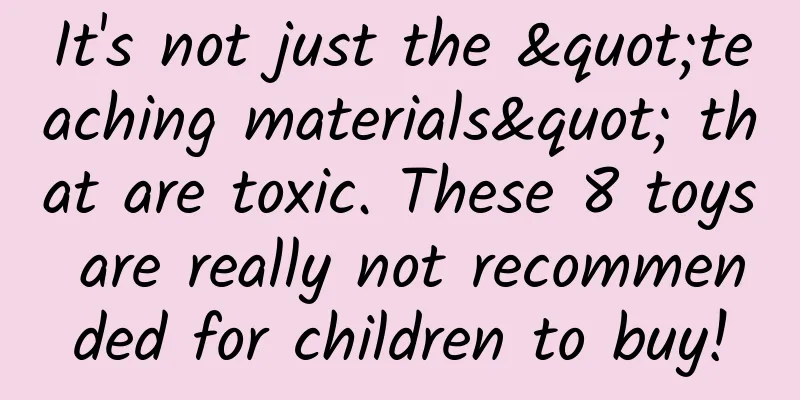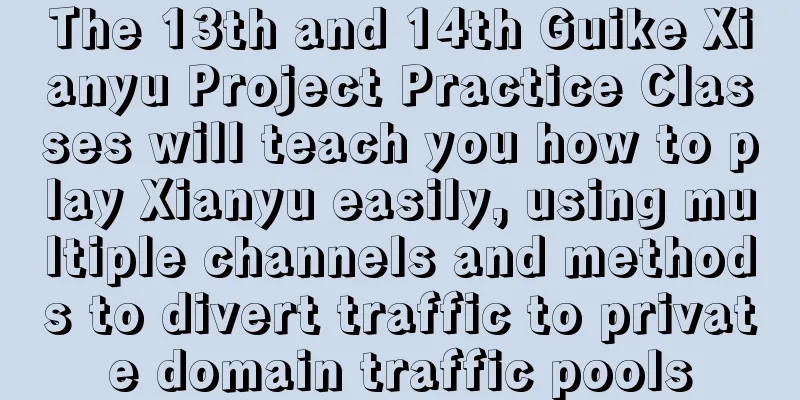How to review activity operations!

1. What is a review?Review, this word comes from the game of Go. Its original meaning is that after finishing a game, players will replay the game on the board to see which parts went well, which parts did not go well, and which parts could have been played differently or even better. Extended to actual work, it actually means re-interpreting past events based on the results and gaining a deeper understanding from them. Many students tend to confuse the concepts of summary and review, but in fact, there are obvious differences between the two in actual operation: ① Structural difference: The classic and common structure for reviewing a situation is the GRAI model, which sorts out the goals and results, reviews the operational details, and finally proposes an optimization plan. A summary is mainly a report on a certain period of work or an event. Each person reviews and describes the events, behaviors and results that have occurred according to his or her own habits and understanding. There is usually no fixed template or structure. From this perspective, review can be said to be a structured summary method. ② Different focus: Reviewing is generally learning-oriented. It does not emphasize performance achievement, but focuses on sorting out past actions, learning experiences and lessons from the process, finding areas for improvement, and allowing individuals or teams to have higher work efficiency in specific modules. General work summaries tend to focus on stating one's own achievements, with little or no mention of defects and shortcomings. ③ Different levels of prestige: For example, both are reviewing a week's work; "I am writing a weekly summary" VS "I am reviewing the gains and losses of this week's work" which one feels higher (purely for fun hahahahaha) 02. How to reviewNow let's get to the point. How do operations review this? In fact, we mentioned it briefly in Part 1, which is to use the GRAI model. Let's first review what GRAI is: Goal: Review the activity goal When we organize an event, we must have a core goal, such as how many new users will be added, what the ARPU will be, etc. When reviewing, we need to bring up this goal and see whether the current results have achieved the expected goals. At the same time, in combination with the entire activity process, review whether the goals were refined for each key node when the goals were set, and whether the goals were set clearly and specifically enough. If the goal at the beginning is to get as many conversions as possible, drive more traffic to the product, or other vague statements, then it is not surprising that the activity is not effective. Many things fail because of vague goals, such as I want to lose weight, I want to study hard, etc. What kind of goal is a good goal? In fact, there was a relatively complete evaluation method for this problem more than half a century ago, namely the SMART principle Specific, specific. Being able to express your demands in specific language, taking "I want to study hard" as an example, the effect of this goal is obviously not as specific as "I want to improve my English grades." Measurable, measurable. The goals set should be quantifiable into specific data indicators. The goal of “improving English scores” is not as effective as “getting 550 points in the CET-4”. Attainable, achievable. The difficulty of achieving the goal should be relatively moderate, and a goal that can be reached by a little jump will be relatively appropriate. For a friend who has just passed the CET-4, setting a goal of 600 points from the beginning is nothing but a pipe dream. Unrealistic goals will only have a counterproductive effect. Relevant: relevant. The other sub-goals we set should be related to the key goals. For example, if we want to improve our English scores, the detailed goals we should set should be to memorize 50 words every day, rather than solving two advanced math problems every day, because it does not help improve our English scores. Time-bound, with a clear deadline. Goals should have time limits. Whether the deadline is tomorrow or next year will have a great impact on the progress of the entire event. No matter what kind of problem you are facing, setting a clear, quantifiable, executable, relevant and DDL goal for yourself first can help you quickly solve the current problem to a great extent. Result: State the result of the activity Although we are all result-driven at work, for review, replaying the entire process of the event is more important than simply focusing on the final result, because the secondary deduction of the process can allow us to break out of the limitations of the environment at the time and look at the problems in the entire activity chain and the areas that are worth reusing from a global perspective. If it is a non-public review, be sure to sort out the measurement indicators of all key nodes, treat each process indicator as a result indicator, and conduct in-depth analysis. There are two more details worth noting when presenting the results: ① Only describe the results, without analyzing the causes When stating the results, we only need to focus on the achievement of the previous target results and not analyze the reasons for the time being. For example, our Double 11 goal is to achieve a GMV of 3 billion. When reviewing the evaluation results, we only need to truthfully describe the GMV we ultimately achieved. If the answer given in the evaluation results section is "GMV is only 2 billion due to changes in market demand", then our focus will be shifted to market demand analysis. Doing so will cause the next step of cause analysis to focus on the market demand level while ignoring other factors. In addition, it is also questionable whether the reasons for non-compliance that are derived without rational analysis are accurate. ② Just state the facts, no need to elaborate on your opinions Opinions mainly refer to subjective views that have been processed by individuals, which are generally easy to cause disagreements. In Guangdong in winter, you can see a very interesting phenomenon: walking on the road, some people are shivering in down jackets and saying "it's so cold today", while others are not afraid at all in short-sleeved shirts and shorts and feel particularly comfortable. In this scenario, "it's very cold today" is just a point of view. Even if 99% of the people on the street are wearing down jackets, you cannot say that the person who thinks "the weather is comfortable" is abnormal, because different people have different points of view. Only something like "the lowest temperature in Guangzhou today was 1℃" can be called a fact. Analysis: In-depth analysis process When presenting the results, our final output should be "This Double Eleven achieved a GMV of 2 billion, 1 billion away from the target" Then, our focus is to analyze why this 3% difference occurs. Here, we mainly use process deduction to analyze The first step is to take out the detailed plan formulated before the activity, mark the small goals and implementation status of each core node, and then, based on the actual implementation situation, gradually review and deduce from the preliminary preparations, and reproduce the entire implementation process in writing (usually in the form of a flowchart), match it with the problems recorded during the execution process, and find out the deficiencies and highlights in the execution. Through process deduction we can easily find the problem, but finding the problem does not mean the end. What we need to do here is to trace back to the core of the problem and solve it fundamentally. In the process of tracing the source of the problem, one tool that can be used is the 5why analysis (also known as Toyota's 5-question analysis method), which is to ask 5 whys in succession until the deep-seated causes and solutions behind the problem are found. The former president of Toyota once gave an example to find out the real reason for machine downtime: Question 1: Why did the machine stop? Answer 1: Because the machine was overloaded, the fuse burned out. Question 2: Why is the machine overloaded? Answer 2: Because the bearings are not lubricated enough. Question 3: Why are bearings under-lubricated? Answer three: Because the lubrication pump failed. Question 4: Why does the lubrication pump fail? Answer 4: Because its axle is worn out. Question 5: Why does the axle of the lubrication pump wear out? Answer five: Because impurities got inside. After asking "why" five times in a row, we finally found the real cause of the problem and the solution: installing a filter on the lubrication pump. Insight: Regularity summary and optimization The ultimate goal of reviewing is to summarize a set of effective methodologies to guide future actions. Therefore, attributing problems and summarizing patterns can be said to be the most important part. When attributing problems and optimizing solutions, there is a very easy mistake to make, which is external attribution, that is, attributing the main cause to uncontrollable factors. As in the example above, GMV was not achieved due to market factors, which is a very obvious external attribution. To sum up at this point, you will find that it is difficult for you to do anything (even giving others a feeling of shirking responsibility, even if this conclusion has a certain truth), because we can't force the market to accept only our products, right? The final point of the summary should be what we did right or wrong in this matter and how we should deal with the same thing in the future. Following the example above, what we need to reflect on at this stage is what kind of preemptive response measures we can take in the future. For example, should we start doing a dynamic analysis of consumer preferences three months before a big sale, understand market trends and then develop products, instead of just relying on the boss’s own judgment to decide which products to promote when the sale is approaching? If the main product encounters insufficient traffic/conversion during a promotion, is there a plan B to supplement traffic or increase conversion instead of just sitting there and waiting for failure? After summarizing and refining each process, the final result should be: who handles what at what time, with a clear To-Do List, and which details need to be focused on and risks avoided. 03. SummaryReviewing is to discover problems, learn from experience and grow by recreating past events, reviewing and reflecting on thoughts. It is not necessary to write a long and boring analysis every time you review. What is more important is to integrate the thinking of reviewing into your daily life. Even if you only review today's work and how you handled affairs before going to bed, you can reap good rewards if you persist. (Daily review template) Finally, let’s review what we talked about in the review: So we have finished talking about everything from pre-event planning, traffic generation, launch to the final review in 4 articles. We talked more about the "technique", and then we will talk about the "Tao", which is thinking. I especially hope that reading these four articles can be of some help to you. If you have any other gains, please leave a message in the background to tell me~ Finally, thank you for your patience in reading so many words, haha~ Author: Fat Tea Adventure Source: Feicha Adventure (ID: gh_89d54415eb1e) Related reading: 5 tips for event management! 3 steps to disassemble event operations! A complete event operation and promotion! The 4 core elements of Internet activity operation and promotion! |
<<: Brand marketing promotion丨These 3 methods make products more popular with users!
>>: How can a novice do a good job in business promotion?
Recommend
Is the investment cost of Ezhou Finance Mini Program high? Ezhou Finance Mini Program Investment Fees and Process
The advantages of WeChat mini program investment ...
Will money be deducted if the WeChat payment code is photographed?
Now WeChat payment has become an indispensable pa...
Why does a black rhino have to hang upside down when it takes a flight? Can't it just lie flat?
Image source: Internet Classic brain teaser: How ...
In the hot summer, be careful! The "number one killer" of foodborne diseases may be around you!
This is the 3866th article of Da Yi Xiao Hu On Ju...
2 years, 500 million users, the operating secrets of Wi-Fi Master Key
The Internet industry emphasizes speed and iterat...
Tea Science | Where does the "orchid fragrance" in tea come from? Uncover the mystery of tea aroma
01 What is orchid fragrance? Orchids, a species o...
My friend, you must have wasted more than half of your advertising budget...
A few days ago, I met a friend who worked on home...
A must-read for designers! Product Data Planning Guide
Product data is usually used to measure product h...
How to use “message push” so as not to harass users? ——Taking financial apps as an example
Imagine this scenario: On a clear autumn afternoo...
Double 12 excellent brand promotion cases are here
For operations partners, the activities at the en...
Entertainment TV shows adapted into movies and games: the superficial prosperity of the IP industry
IP really entered the public eye mainly in 2014. ...
【Dream Complete User Manual】Control your dreams and turn your life around
【Dream Complete User Manual】Control your dreams a...
The key method of excellent creative advertising!
Those advertisements that seem creative and amazi...
How should colleges and universities carry out promotion and operation?
College students have 37 million potential users,...
"Mars" faces "Chang'e": "Mars and the Moon" will appear in the sky on the 23rd
According to astronomical science experts, Mars w...









